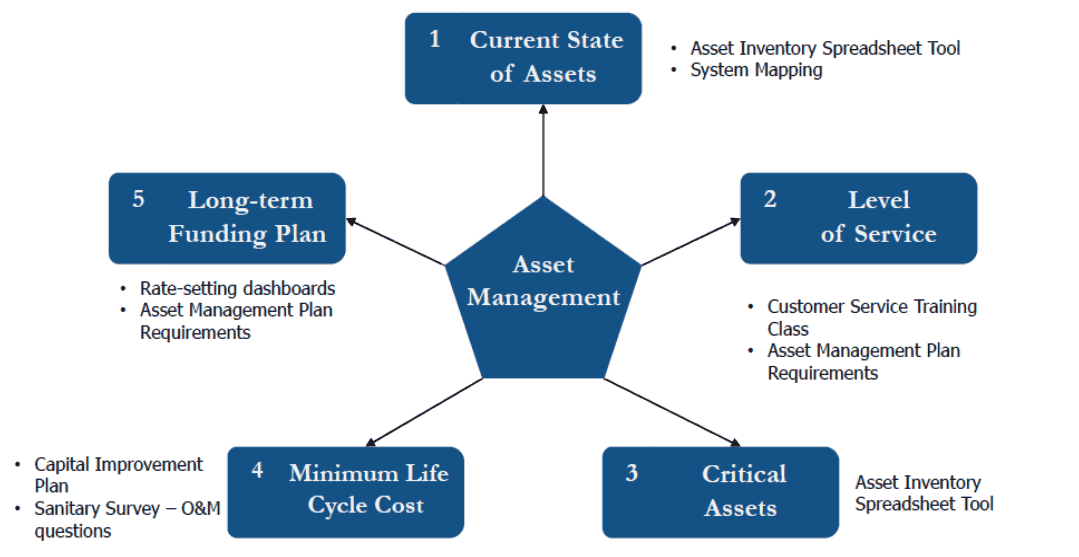Asset Management is a framework for water systems to effectively allocate their resources to balance water quality, cost and requirements.
On this page
What is Asset Management?
Clean, safe drinking water is what all public water systems in Mississippi strive for on a daily basis. Customers want their water to meet the requirements of the Safe Drinking Water Act and remain aesthetically pleasing in the areas of taste, color and smell. Maintaining quality and safety can be challenging as vital assets age or suffer from poor operations or maintenance. Asset Management is balancing resources, time, and funding to meet the sometimes conflicting demands of water demand, quality, cost and safety. Asset Management is a framework to help utilities provide the desired level of service at the lowest life cycle cost. It's also is a way of thinking about management in a more efficient and customer-centric way.
The framework of asset management consists of 5 core concepts:
- Asset Inventory
- Level of Service
- Criticality
- Life Cycle Costing
- Long-Term Funding
Benefits
- Makes the most of your investment in drinking water assets.
- Increases the potential of economic development.
- Ensures good operation and maintenance essential for safety and public health.
- Establishes a key foundation for customer service.
There are practical advantages for operating your water system as well:
- Ensures the long-term sustainability of the drinking water system.
- Better informed decision making on repairs, replacements and the rehabilitation of assets.
- Helps develop a long-term funding plan.
- Can keep costs low by balancing energy efficiency in the asset life cycle against moving forward with a newer technology that could have a lower environmental impact.
Good Business Practice
Good asset management has impacts on the daily/weekly activities, actions taken, and decisions that are made to keeping the water flowing for your customers. It affects funding for needed projects and could become a regulatory requirement for operation and capacity development. Asset management should be the way you do business, not an afterthought or future possibility.
All personnel and decision makers of the water system should support the process, and be aware of conditions so that actions can be taken before failures occur. Complaints of water quality or low pressure may be indicative of a larger problem with key assets that are near the end of their life span. While the benefits may not be immediately realized, and the framework can mean a lot of work to put in place, it will enable the utility to work smarter, not harder.
The Core Framework of Asset Management

Core 1: Current State of Assets
Developing your asset inventory answers common questions about your drinking water assets:
- What assets do I have?
- Where are they located?
- What condition are they in?
- What is their remaining useful life?
- What is their value?
- What is their level of energy efficiency?
Some questions to consider in the process:
- How will I capture this data?
- Where will I keep it?
- Whose job will it be to maintain it?
This is an important step that takes time depending on the number of assets that you have and the level of detail that you will try to achieve. Attempt to get the best data possible, but also consider it a work in progress that adds data over time.
Core 2: Level of Service
Your water system is in the business of providing potable, reliable drinking water at reasonable pressures and flows. Level of service defines what your want your assets to provide and how you want them to perform. It can be a balance of what both the water system and customers decide as long as complies with the required rules and regulations.
What defining level of service does:
- It communicates to the customers.
- It helps identify assets critical to the service of your customers.
- It can be a tool for assessing utility performance.
- It links costs and service.
- It can be a guide for utility management and operations staff.
- It can communicate energy efficiency and water conservation goals.
Level of service establishes goals for your system and for your customers. Good goals are SMART: Specific, Measurable, Attainable, Realistic and Time-bound. Good goals may come at a slightly higher cost, but customers may be willing to take on that cost if service is better.
Goals to consider in determining your level of service:
- What do your customers want?
- What do they expect in the way of pressure and water quality?
- Do they expect a friendly voice when they need help?
- Are you meeting the various rules and regulations associated with the Safe Drinking Water Act (SDWA)?
Core 3: Critical Assets
Not every asset you have is equally important to keeping the water system operating. Consider your system's assets very carefully to decide which assets are critical and why. Considerations for critical assets include:
- How likely is the asset to fail?
- What happens when it does?
- Is there a level of redundancy desired? Are backups needed?
Assets can fail in four ways:
- Mortality: unable to perform its role
- Financial inefficiency: costs to operate exceed its economic benefit
- Capacity: it is operating, but under-performing
- Level of service: operational, but can't meet the needed level of service
The consequence of failure can lead to repair/replacement costs, collateral damage, public health impacts, etc.
Core 4: Life Cycle Costing
This core element involves knowing exactly how much and what type of maintenance to do on an asset during its life, and the correct point to replace the asset that would optimize operational and capital expenditures.
If you knew this information for each and every asset in your utility, you would know that every dollar spent was necessary and that it was being spent at the right time for the right reason. However, to do only the necessary maintenance to get the maximum life out of the asset to the point of failure is almost impossible to predict. To do this more simply:
- Consider the level of risk that was estimated in Core 3.
- Address higher risk assets before the end of their estimated useful lives.
- Decide whether to repair, replace or rehabilitate the asset, based on cost and effectiveness.
Some of your major assets may have individual components that will have independent life cycles that play a role in the longevity of the major asset. That level of detail would need to be taken into consideration as you fine-tune your plan. Elements such as distribution can be a fairly complicated network of materials and sizes that have to balance with the effort of maintenance and the true-life cycle costs.
Life cycle planning leads to capital improvement planning, where you prioritize expenditures over the next 5, 10, or even 20 years to determine necessary maintenance for your system to continue to be sustainable and achieve your service goals.
Core 5: Long-Term Funding
Managing and operating a water system at a desired level of service and reasonable cost to your customers requires that you have a sustainable funding strategy.
You should fund the operation and maintenance, repair, rehabilitation and replacement of assets at an appropriate level thought internal funding and external funding.
External funding for capital projects comes from loan and grant programs and from bonds. Most federal and state loan and grant programs fund only capital projects, and the water system is responsible for the overall operations and maintenance. When your water system applies for funding from state and federal agencies for capital expenses, you are more likely to be successful if you demonstrate that your rates are sufficient to cover the added operation and maintenance costs that the new project might incur.
Internal funding for day-to-day operations comes from water system rates and fees. These rates and fees should be sufficient to recover the cost of operations. Besides customer rates, a utility may have other fees such as connection fees, stand-by fees, reconnection fees, and developer impact fees.
Getting Started
Implementation may seem daunting, but it is a best practice to your water system's long-term sustainability. Let the core elements be your guide, and let your program evolve over time just as your assets and staffing change over time.
To aid you in the effort, the MSDH Bureau of Public Water Supply has compiled various resources, including an asset management template based in Microsoft Excel that guides you through many of the core elements of asset management.
- Example Plan XLSM Excel document with data for an example asset management plan
- Planning template XLSM Blank Excel template for developing your own plan
References and Resources
- Asset Management: A Handbook for Small Water Systems (2003)This guide is one in a series of Simple Tools for Effective Performance (STEP) developed for small drinking water systems.
- Taking Stock of Your Water System: A Simple Asset Inventory for Very Small Drinking Water Systems (2004)This guide was developed by the EPA for very small systems such as manufactured home communities and homeowners' associations. It was designed as a simplified process to determine condition and useful life of assets.
- Bridging the Gap: Video for Public Officials and Water Managers.Bridging the Gap is an on-line video designed to help elected officials and water and wastewater managers make smart infrastructure choices. The video outlines the key steps to developing an Asset Management plan. The website provides an on-line learning experience with reference materials and real-world examples.
- Life-Cycle Cost AnalysisU.S. Department of Energy's Federal Energy Management Program tools, software, training and publications.
Rate-Setting and Financing
- Setting Small Drinking Water System Rates for a Sustainable Future - STEP Guide Series (January 2006, 62 pages)This guide provides information on the importance of recovering costs through user fees and developing a budget and financial plan. (EPA 816-R-05-006)
Strategic Planning
- Strategic Planning: A Handbook for Small Water Systems - STEP Guide Series (September 2003, 30 pages)This guide was designed to assist systems understand the concept of strategic planning.

